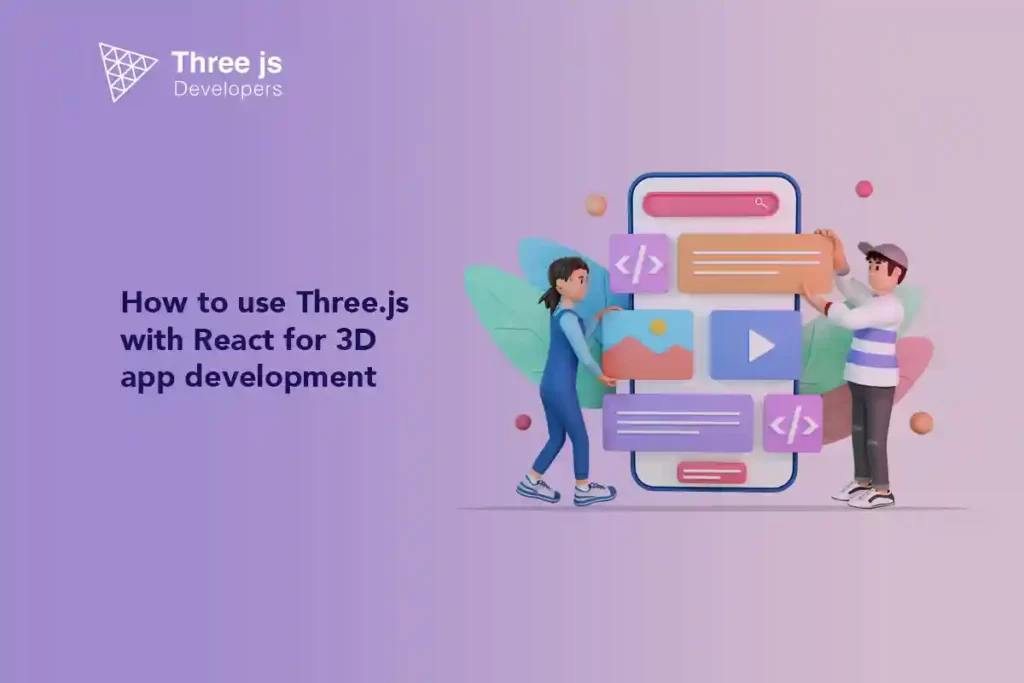Do you find yourselves curious about the fascinating world of 3D application development? This piece is crafted especially for you. We’re diving deep into a cutting-edge combination that’s been stirring up quite the buzz in the tech universe, React and Three.js. Trust me, by the time you’ve journeyed with us to the end of this article, you’ll have a comprehensive understanding of why React and Three.js combination reshapes the landscape of 3D app development.
The Synergy of React and Three.js in 3D App Development
React, a powerful JavaScript library recognized for its versatility, speed, and optimization, allies with Three.js, the esteemed go-to library for creating immersive 3D graphics on the web. A perfect pairing from the developer’s paradise. But what exactly does this power duo bring to the table?
By combining React’s declarative programming style with Three.js’ extraordinary 3D capabilities, developers can effortlessly manage 3D objects in a virtual DOM, boosting performance and readability. React’s reusable components and Three.js’s extensive 3D library allows for a dynamic, rich, interactive user experience.
Take, for instance, online gaming. With this potent combo, creators can build engaging, impressively fast, and responsive games. Another arena? Data visualization. Imagine complex data displayed in a visually enticing 3D format that captivates while simplifying comprehension.
And to top it all off? The use of these technologies together dramatically enhances the development workflow. By merging React’s component-based architecture with Three.js’ flexibility, we see a substantial improvement in the maintainability and scalability of projects. A win-win situation for developers and users alike.
Using Three.js with React for 3D App Development
We’ll explore how React, our trusty JavaScript library, becomes a worthy partner to Three.js in crafting incredible 3D applications. We’ll start by setting up a stable development environment, then build our first, albeit simple, 3D scene. But we won’t stop there. Next, we’ll amp up our scene, infusing it with animations, interactions, lighting, and textures. Finally, we’ll fine-tune our creation, optimizing it for the best performance and compatibility. By the end, you’ll witness the transformative potential of React and Three.js in 3D app development.
Setting up Your Development Environment
In the first part of this exciting journey, let’s start by preparing our development environment. The marriage of React and Three.js may seem challenging, but with the right toolkit, we’ll set the stage for a seamless development experience.
First, Node.js and npm (node package manager) are a must-have, so if they’re not already part of your development arsenal, go ahead and download them. They’ll help you manage dependencies and run necessary build scripts.
Next, the ‘Create React App’ boilerplate is handy for getting your React app off the ground without worrying about setup details. Now, onto adding Three.js into our mix; all it takes is a simple command: npm install three.
As for the recommended development tools, Visual Studio Code, with its array of extensions and powerful IntelliSense, tops our list. ESLint and Prettier, meanwhile, are your best friends for code formatting and spotting potential errors. Remember, a clean, well-organized codebase is easier to work with and understand.
Building a Basic 3D Scene Using Three.js and React
Now that our toolbox is set, let’s dive into the real fun: creating our first 3D scene. Let’s start with a simple spinning cube, the ‘Hello, World!’ of the 3D universe.
The beauty of Three.js is that it abstracts many of the complexities of WebGL, letting us focus on the bigger picture. In a nutshell, we’ll first set up a scene, a camera, and a renderer, then create a cube and add it to our scene. All these happen inside a React component’s lifecycle methods for a clean and organized code structure.
Watch this space as we walk you through each step, unpacking the magic behind the lines of code and taking our first step into the 3D world within our React application.
Enhancing Your 3D Scene
Our cube is spinning, and our scene is alive. But what’s a 3D world without a bit of drama? Animations, interactions, lighting, and textures are essential to an immersive 3D experience.
Animations breathe life into our cube. With a requestAnimationFrame function inside our React component’s render method, we can create a loop that repeatedly renders our scene, making the cube spin.
Interactions, such as mouse events, take user engagement to a new level. Lighting and textures, meanwhile, add depth and realism to our scene. Three.js offers ambient, point, and directional lighting options, to name a few. As for textures, they can be anything from an image file to dynamically generated content.
Optimizing Your 3D React App
As we near the end of our journey into 3D app development with React and Three.js, we arrive at a crucial junction, optimization. Building an interactive, engaging 3D application is a fantastic feat, but proper optimization is necessary for the user experience to continue.
Optimization takes on numerous facets in this context. From reducing asset sizes to enhancing load times, to efficiently rendering scenes and limiting costly operations – these elements collectively contribute to the performance of your application. It’s about balancing visual allure with functional efficiency.
It’s important to note that optimizing a 3D React app isn’t an afterthought but an ongoing, integral part of the development process. By carefully considering these factors from the outset, you ensure your app runs smoothly across different devices and platforms. Hence, optimization isn’t just an end step but the thread that weaves throughout creating a top-notch 3D React app.
Conclusion
And there you have it! We’ve covered some ground, from setting up your development environment to enhancing and optimizing your 3D app. We’ve glimpsed the incredible potential that React and Three.js hold for 3D application development.
Remember, what we’ve explored is just the tip of the iceberg. The scope of what you can achieve with this power combo is vast and limited only by your imagination. So, experiment, create, and, most importantly, have fun with this dynamic duo in 3D app development.



